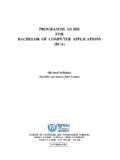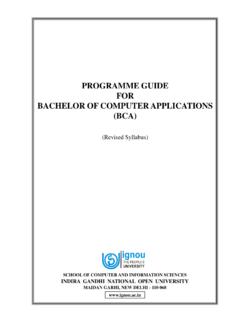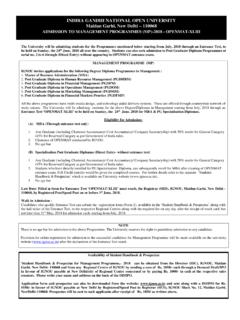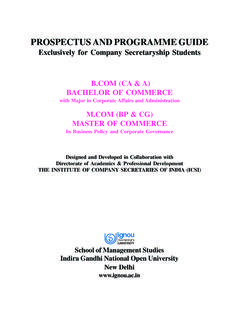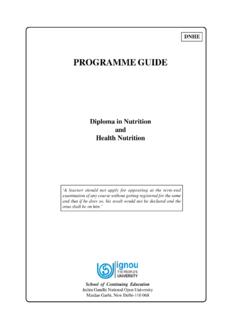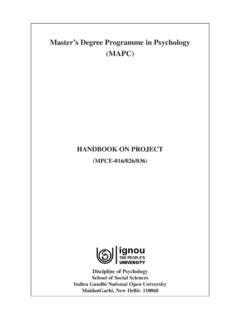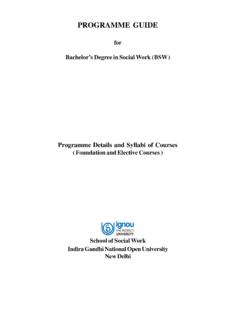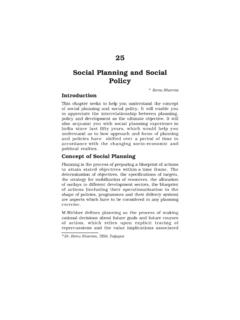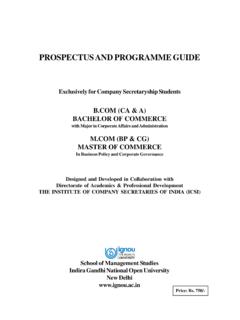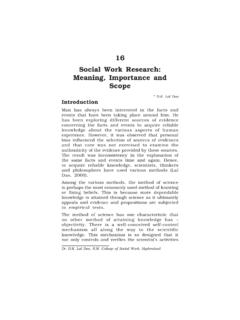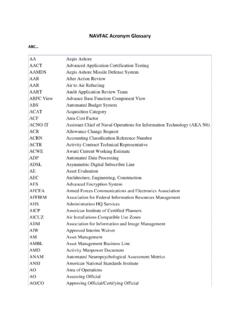Transcription of UNIT 9 COMPUTER AIDED PROCESS Computer Aided …
1 15 COMPUTER AIDED PROCESS Planning UNIT 9 COMPUTER AIDED PROCESS PLANNING (CAPP) Structure Introduction Objectives Introduction to PROCESS Planning Approaches to PROCESS Planning Manual Experience-based PROCESS Planning COMPUTER AIDED PROCESS Planning Approaches to COMPUTER AIDED PROCESS Planning (CAPP) Variant PROCESS Planning, Advantages and Disadvantages Generative PROCESS Planning, Advantages and Disadvantages Knowledge-based PROCESS Planning Variant or Generative, Which to Use? Feature Recognition in COMPUTER AIDED PROCESS Planning Approaches to Part Feature Recognition Attributed Adjacency Graph Based Approach for Feature Recognition An Illustrated Example Recent Trends in COMPUTER AIDED PROCESS Planning Summary Key Words Answers to SAQs INTRODUCTION Before introduction to the role of COMPUTER AIDED PROCESS planning (CAPP), it is worthwhile to understand the role of PROCESS planning in the product cycle.
2 Once the design of the product has been evolved from customer s views, its manufacturing necessitates careful planning and scheduling of the various processes of manufacture. So that, the product is made to right specifications and delivered at the right time at a minimal cost. The cycle from concept to design, planning, production, quality control and feedback to design goes on in which one can easily understand the crucial role of planning. In job/batch manufacture, as an enormous amount of data is needed for planning as well as other activities, data bases are required and the flow of information should be fast for a high performance of the total manufacturing system. Objectives After studying this unit, you should be able to understand what is PROCESS planning and CAPP, know the various steps involved in CAPP, classify the various methods of CAPP, and understand the feature recognition in CAPP. INTRODUCTION TO PROCESS PLANNING In manufacturing, the goal is to produce components that meet the design specifications.
3 The design specification ensures the functionality aspect. Next step to follow is to assemble these components into final product. PROCESS planning acts as a bridge 16 CIM Modelling and Operations between design and manufacturing by translating design specification into manufacturing PROCESS detail. Hence, in general, PROCESS planning is a production organization activity that transforms a product design into a set of instruction (sequence, machine tool setup etc.) to manufacture machined part economically and competitively. The information provided in design includes dimensional specification (geometric shape and its feature) and technical specification (tolerance, surface finish etc.) Now-a-days, PROCESS planning is applied to many manufacturing industries like metal cutting, sheet metal forming, composite and ceramic fabrication and other manufacturing processes. Figure represents the various steps involved in developing a PROCESS plan.
4 Error! Figure Various steps are discussed as follows : The analysis of finished part requirement is the first step in PROCESS planning. Initially the features of parts are analyzed. Examples of geometric feature include plane, cylinder, cone step, edge and include fillet. These common features can be modified by the addition of slots, pockets, grooves, holes and others. The second step is the selection of raw work piece shape, size (dimensions and weight), material and other attributes are determined. Weight and material of the raw part are determined by the functional requirement of plan. The next logical step in PROCESS planning is to determine the appropriate types of processing operations and their sequences to transform the features, dimensions and tolerances of a part from the raw to the finished state. There may be many ways to produce a design some times constraints are also considered like some feature be machined before or after other.
5 Furthermore, the types of machine, available tools as well as batch size influence the PROCESS sequence. Next step to be followed in PROCESS planning is the selection of machine tools on which these operations are made. Implementation Yes No Selection of Raw Workpiece Determining Manufacturing Operation and their Sequences Selection of Machine Tools Selection of Tools, Work Holding Devices (Fixtures) and Inspection Equipments Determining Machine Conditions (Cutting Speed, Feed, and Depth of Cut and Manufacturing Times (Processing Time and LeadTime) Design Specification Analysis of Part Requirements PROCESS Planner Required Product 17 COMPUTER AIDED PROCESS Planning Some of the factors which influences the selection of machine tool are as follows : (i) Attributes related to workpiece, such as desired features, dimensions of workpiece, dimensional tolerances and raw material form. (ii) Attributes related to machine tools, PROCESS capability size, mode of operation, tooling capabilities and automatic tool changing capabilities.)
6 (iii) Attribute related to production volume, production quantity and order frequency. Unit cost of production, manufacture lead time and quality are three basic criteria for evaluating the suitability of a machine tool to accomplish an operation. Next step to be followed is the selection of tools work holding devices and inspection equipments. Features on the workpieces are generated using a combination of machine tool and cutting tools. Work holding devices are used to locate and hold the workpiece to generate features. In order to ensure the dimensional accuracy, tolerance and surface finish on the feature, inspection equipments are required. Part features play a vital role in the selection of machine tools, fixture and inspection equipment. Now sixth step which has to be performed is the determination of machining condition and manufacturing time. The controllable variables of machine condition are cutting speed ( ), feed (f) and depth of cut (d).
7 Minimum cost per piece, maximum production rate and manufacture lead time are same for the model to be optimized for high production and less cost. APPROACHES TO PROCESS PLANNING There are basically two approaches to PROCESS planning which are as follows : (i) Manual experience-based PROCESS planning, and (ii) COMPUTER - AIDED PROCESS planning method. Manual Experience-based PROCESS Planning The steps mentioned in the previous section are essentially same for manual PROCESS planning. Following difficulties are associated with manual experienced based PROCESS planning method : It is time consuming and over a period of time, plan developed are not consistent. Feasibility of PROCESS planning is dependent on many upstream factors (design and availability of machine tools). Downstream manufacturing activities such as scheduling and machine tool allocation are also influenced by such PROCESS plan. Therefore, in order to generate a proper PROCESS plan, the PROCESS planner must have sufficient knowledge and experience.
8 Hence, it is very difficult to develop the skill of the successful PROCESS planner and also a time consuming issue. COMPUTER - AIDED PROCESS Planning COMPUTER - AIDED PROCESS planning (CAPP) helps determine the processing steps required to make a part after CAP has been used to define what is to be made. CAPP programs develop a PROCESS plan or route sheet by following either a variant or a generative approach. The variant approach uses a file of standard PROCESS plans to retrieve the best plan in the file after reviewing the design. The plan can then be revised manually if it is not totally appropriate. The generative approach to CAPP starts with the product design specifications and can generate a detailed PROCESS plan complete with machine settings. CAPP systems use design algorithms, a file of machine characteristics, and decision logic to build the plans. Expert systems are based on decision rules and have been used in some generative CAPP systems.
9 CAPP has recently emerged as the most critical link to integrated CAD/CAM system into inter-organizational flow. Main focus is to optimize the system performance in a 18 CIM Modelling and Operations global context. The essentiality of COMPUTER can easily be understood by taking an example, if we change the design, we must be able to fall back on a module of CAPP to generate cost estimates for these design changes. Similarly for the case of the breakdown of machines on shop floor. In this case, alternative PROCESS plan must be in hand so that the most economical solution for the situation can be adopted. Figure is one such representation, where setting of multitude of interaction among various functions of an organization and dynamic changes that takes place in these sub functional areas have been shown. Hence, the use of COMPUTER in PROCESS planning is essential. Figure : Framework for COMPUTER AIDED PROCESS Planning CAPP is the application of COMPUTER to assist the human PROCESS planer in the PROCESS planning function.
10 In its lowest form it will reduce the time and effort required to prepare PROCESS plans and provide more consistent PROCESS plan. In its most advanced state, it will provide the automated interface between CAD and CAM and in the PROCESS achieve the complete integration with in CAD/CAM. Advantages Over Manual Experience-based PROCESS Planning The uses of computers in PROCESS plan have following advantages over manual experience-based PROCESS planning : (i) It can systematically produce accurate and consistent PROCESS plans. (ii) It leads to the reduction of cost and lead times of PROCESS plan. (iii) Skill requirement of PROCESS planer are reduced to develop feasible PROCESS plan. (iv) Interfacing of software for cost, manufacturing lead time estimation, and work standards can easily be done. (v) Leads to the increased productivity of PROCESS planar. With the emergence of CIM as predominate thrust area in discrete part industries PROCESS planning has received significant attention, because it is the link between CAD and CAM.
